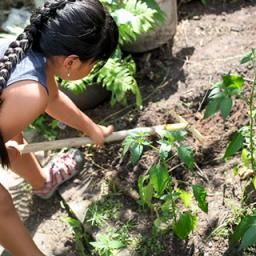A Garden in Lawndale
A catalyst is a spark. It is the start of a change. As you read this report, think what the spark was.
Eighth grade students at a school in Lawndale saw new buildings. Families were moving into the community. But they saw vacant lots, too. They saw trash there. Even when they picked up the trash, the lots did not stay
clean. Wind blew trash there from the street. “No one can do anything about this,” said one student. “Yes, we can,” said another. Their teacher agreed. They would plant a garden in a vacant lot.
Their teacher showed them pictures of the community long ago. She showed them that it used to have great gardens. The students said they could make this change. It was after Barack Obama had been elected. His slogan had been “Yes, we can.” They believed it. They would prove it.
The students met with the principal. They asked if they could create a community garden in the vacant lot closest to the school. She told them that was a great idea, but they would have to volunteer their own time and work on it every week. The students agreed. They promised they would donate their time every Saturday until it snowed. Even then they would keep the sidewalk cleared near the lot.
The students needed to collaborate with the community. They wanted to be sure that everyone in the community wanted the garden. They met with block clubs and told them their plan. The block clubs applauded the project. They said they would help.
The students went on the Internet to learn about plants. They looked for plants that would grow well in Chicago. They chose some evergreen plants. They chose some bulbs, too. They learned a lot about plants and gardening.
The students needed money to get the bulbs and plants. They needed tools, too. They made a budget. They sent that budget and their plan to get funding. A Foundation funded their plan. The students got $300 to buy what they needed.
They are 8th graders, so this spring they will meet with the seventh grade. They will ask them to take over the garden. It will be their legacy to the school
community.
